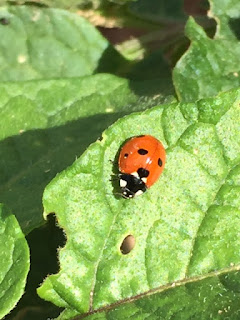 |
| Lady Beetles Feast on Aphids & Potato Beetle Eggs |
Ladybug, Ladybug, Fly Away Home,
Your House is on Fire, Your Children Are Gone!
As many nursery rhymes do, this one seems a bit scary for children, but examining its origins reveals the message was intended to protect this helpful insect.
 |
| Colorado Potato Beetles Decimate Plant Leaves |
 |
| Lady Beetle on Potato Leaf Damaged by Potato Beetle |
 |
| Colorado Potato Beetle Eggs |
 | |
| Asian Lady Beetle |
 |
| Native Lady Beetles Overwinter in Trees |
In an attempt to enlist protective help for native species from US citizens, Cornell University entomologist, John Losey, created the Lost Ladybug Project
Losey's site encourages people to photograph lady beetles and send the images to the project. As of May 5, 2016, over thirty-five thousand lady beetle images have been submitted and the site includes an identification guide for various species, some of which are considered endangered and very rare.
 |
| Squashing Potato Beetle Eggs: Do Lady Beetles Eat Them Scrambled? |
With beautiful weather forecast for the weekend, head to the nearest organic garden or your own backyard to observe lady beetles. Capture photographs and compare the species you discover to an identification guide. Perhaps you will be fortunate and observe a rare nine-spotted ladybug or the two-spotted native. Regardless of the species you see, pause to be grateful for these farmer-friendly insects and the work they do to control pests.








0 comments:
Post a Comment